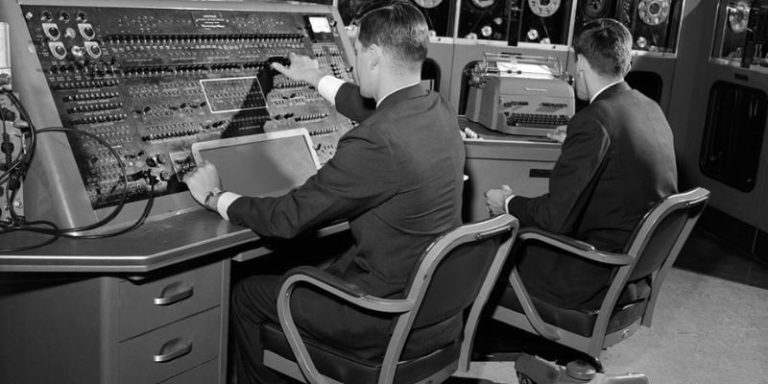This Week in History: June 12-18
The world’s first electronic digital computer is revealed.
By: Kelli Ballard | June 12, 2022 | 834 Words

(Photo by H. Armstrong Roberts/ClassicStock/Getty Images)
“I’ve been completely fascinated with history because it tells everything about what’s going to happen next because it’s cyclical, everything repeats in general.” ~Emile Autumn
June 14, 1951: World’s First Commercial Electronic Computer, UNIVAC, Was Revealed
Computers today are much different than their ancestors. Earlier computers were much larger, taking up entire rooms just for one machine, and they didn’t have all the fancy user-friendly options we have today. So, on June 14, 1951, when the US Census Bureau dedicated UNIVAC (Universal Automatic Computer), it was a big deal.
This was the first electronic digital computer that was commercially produced in the United States. J. Presper Eckert and John Mauchly led the team of engineers to develop this new technology. They were also the ones to create ENIAC (Electronic Numerical Integrator and Calculator), which was the first general-purpose digital computer.
UNIVAC weighed over 16,000 pounds. On November 4, 1952, it accurately predicted a landslide victory for Dwight D. Eisenhower in the presidential election with only a few votes in.
Some might argue, however, that the UNIVAC is not really the first computer. Humans have been looking for ways to complete calculations for centuries. In ancient times, the Romans, Chinese, and Babylonians developed various types of abacus – a primitive sort of calculator. In 1642, France, a mechanical calculating machine was created. And, in the 1830s, Englishman Charles Babbage invented what he called his “Analytical Engine” that devised most of the modern computer principles we use today. Babbage’s work, however, was never finished due to lack of money and conflict with his chief engineer.
Other Notable Mentions
June 12, 1898: The Philippines, named after King Philip II, declared independence from Spain.
June 12, 1963: Medgar Evers, a civil rights leader who fought for integration of schools, was assassinated in Jackson, Mississippi.
June 13, 1971: The New York Times started publishing a collection of top-secret documents called the Pentagon Papers that exposed the United States’ strategy in the Vietnam War.
June 13, 1966: The Supreme Court ruled in the Miranda v. Arizona case that people have to be notified of their rights before police officers can question them, including the right to remain silent.
 June 14, 1775: The Second Continental Congress established the first US military service – the Continental Army. It consisted of six companies of riflemen. George Washington was unanimously voted to command the army.
June 14, 1775: The Second Continental Congress established the first US military service – the Continental Army. It consisted of six companies of riflemen. George Washington was unanimously voted to command the army.
June 14, 1777: John Adams suggested Congress mandate a flag, saying, “…that the flag of the thirteen United States shall be thirteen stripes, alternate red and white; that the union be thirteen stars, white on a blue field, representing a new constellation.” This is why we celebrate Flag Day on this date.
June 14, 1922: President Warren G. Harding became the first commander-in-chief to broadcast a message over the radio.
June 15, 1215: King John of England approved the Magna Carta, which guaranteed basic human rights and became the foundation of modern democracies.
June 16, 1963: Valentina Tereshkova became the first woman in space. She was 26 years old.
June 17, 1972: Five men were arrested at the National Democratic Headquarters in the Watergate complex. It was discovered the men had been hired by the Committee for the Re-Election of President Richard Nixon and became the Watergate Scandal.
June 18, 1812: The Senate voted to declare war against Great Britain which began the War of 1812.
June 18, 1983: Dr. Sally Ride, aboard the space shuttle Challenger, became the first American female in space.
Famous Birthdays
George Bush (June 12, 1924) was born in Milton, Massachusetts. He was the youngest pilot in the Navy until in 1988, he became the president of the United States.
Anne Frank (June 12, 1929) was born in Frankfurt, Germany. A victim of the Nazi Holocaust, she wrote her famous diary describing her experiences.
William Butler Yeats (June 13, 1865) was born in Dublin, Ireland. He was an Irish poet and won the Nobel Prize.

Harriet Beecher Stowe (Getty Images)
Winfield Scott (June 13, 1786) was born in Petersburg, Virginia and was an Army general who served in the War of 1812, the Mexican-American War, and the Civil War. His nickname was “Old Fuss and Feathers.”
Margaret Bourke-White (June 14, 1906) was born in New York City, New York. She was a photojournalist and one of the original four staff photographers for Life Magazine. She was also the first woman to become accredited as a World War II correspondent.
Harriet Beecher Stowe (June 14, 1811) was born in Litchfield, Connecticut. She wrote Uncle Tom’s Cabin, which condemns slavery and gives vivid descriptions of the hardships.
John Bartlett (June 14, 1820) was born in Plymouth, Massachusetts. He created Bartlett’s Familiar Quotations, which is one of the most-used reference books.
Alois Alzheimer (June 14, 1864) was born in Marktbreit am Mainz, Germany. He published an article that described Alzheimer’s disease, which led to the disease being named after him.
Stan Laurel (June 16, 1890) was born in Ulverston, England. A film comedian, he was part of the Laurel and Hardy Show.
George Mallory (June 18, 1886) was born in Mobberley, Cheshire, England. He was an explorer who climbed Mount Everest “because it is there.”
















